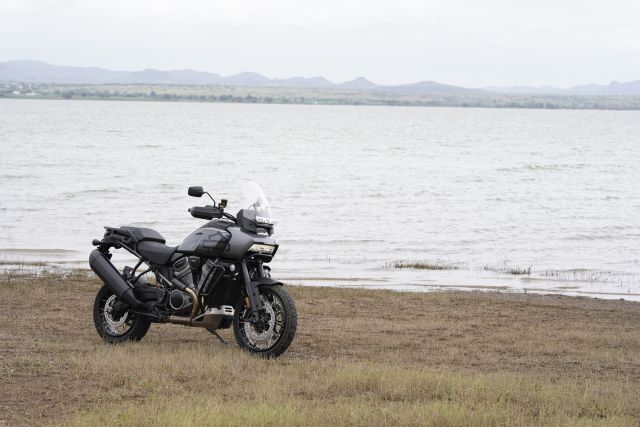
Harley-Davidson finally step out of their comfort zone and bring us a modern, all-American adventure bike
Story: Anosh Khumbatta
Photography: Sanjay Raikar
This has been a long time coming. Harley-Davidson have been hinting at a departure from their staple diet of laid-back cruisers for years now and we’ve been waiting with bated breath to see what the Motor Company has up its sleeve ever since the Pan America was announced. I was lucky enough to see a prototype in the flesh at EICMA 2019, although it was enclosed in a glass case at the H-D stand; so, getting hands-on wasn’t an option. Last year saw BMW Motorrad launch a salvo into the heart of H-D territory with the introduction of the massive R 18, looking for a slice of the American cruiser market, making this the perfect time for Harley to respond in kind, with a motorcycle aimed directly at the BMW GS and its hold on the adventure touring market. The Harley-Davidson Pan America has been received very well in international markets and now, almost two years after that first sighting in Milan, it’s finally standing here before me.
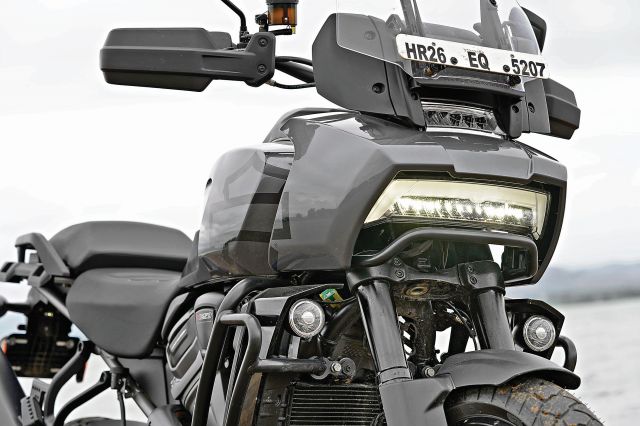
As is clear from these photos, the Harley-Davidson Pan America looks the part of a formidable, no-nonsense machine. That striking design is sure to polarise opinions, and its tall, rangy attitude seemed quite out of place at the H-D dealership. There’s no prominent beak up front, like we’ve come to expect of adventure bikes these days; instead, the boxy bodywork and wide, low-mounted headlight share a family resemblance with the Road Glide and Fat Bob models, and give the Pan Am an unmistakeably Harley-Davidson visage. Above the main headlight is a panel for the cornering lights that illuminate the inside of corners as lean angles increase while, further up, the squarish screen does a great job of insulating the rider from the elements. An H-D Bar and Shield logo flows from the bodywork on to the fuel-tank, while the rest of the bike is free of any ornamentation in the form of plastics or decals. I especially liked the exposed rear subframe which adds an industrial, heavy-metal touch to the already butch-looking motorcycle. Cross-laced anodized aluminium spoked wheels in 19-inch and 17-inch diameters give the bike a stance in line with that of other large ADVs, and are shod with tubeless Michelin Scorchers specially developed for the Harley-Davidson Pan America. The large 21.2-litre fuel-tank features shallow knee recesses, and curves down to meet the extremely comfortable rider’s seat which, at 830 millimetres high, was a bit of a stretch for 5’ 5” me. The riding ergos however fit me perfectly, with the pegs directly under the seat and the bars within easy reach.
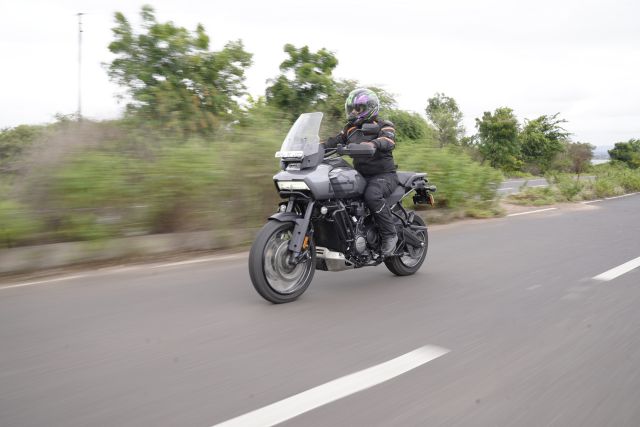
The sturdy-looking 6.8-inch full-colour TFT touchscreen swivels back and forth to suit riders of varying heights, and this is the command centre for the bike’s rather advanced electronics suite. While features and functions can be accessed directly via touch, I actually preferred keeping my hands on the bars and using the chunky switchgear which, though rather complicated-looking, was easy to adapt to once I knew where everything was. The Pan America’s advanced electronics package is just what you would expect to see on a modern adventure bike, and it includes four pre-set riding modes and two fully-customizable ones whereby you can mix and match parameters to your liking. The Pan Am also gets Hill Hold Control, Cruise Control and heated grips. The pre-set modes are Sport, Road, Rain, and Off-Road, while the custom modes give you complete control over the engine map, the amount of engine braking, throttle response, traction control and ABS, as well as suspension damping characteristics in this Special variant which gets Showa semi-active legs at both ends.
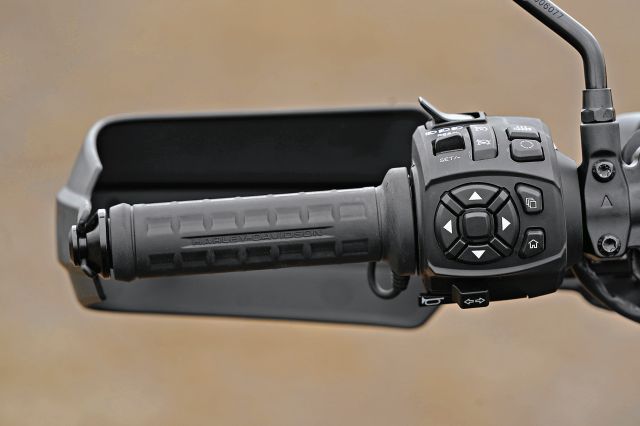
When we think of Harley-Davidson engines, the mind conjures up images of old-school, long-stroke, pushrod-equipped V-twins that don’t rev beyond 5,000 rpm — but that won’t do here. At the heart of the Harley-Davidson Pan America is the all-new Revolution Max motor that engineers have been working on for the last few years, and it’s nothing like the company’s standard fare. This quick-revving, liquid-cooled, 60-degree, 1,252-cc V-twin is a properly modern unit, equipped with dual overhead cams, four valves per cylinder, variable valve timing, and hydraulic valve lifters for a maintenance-free valvetrain, mated to a six-speed transmission. Headline figures are 128 Nm of torque at 6,750 rpm, with power peaking at 152 hp at 8,750 rpm. Yes, that’s right, this Harley revs all the way to beyond 9,000 rpm and produces quite a strong kick throughout the rev-range. The steel trellis forward frame, aluminium mid frame, and steel rear subframe are all bolted directly to the engine which acts as a stressed member, ensuring a lightweight and rigid chassis structure.
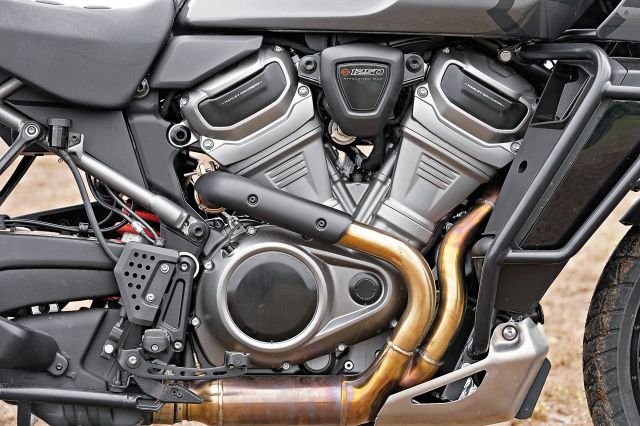
The big V-twin comes to life with an angry snort, immediately settling into a lumpy idle; a blip of the throttle brings forth a bark that reminds me more of a big European V-twin than a product of Milwaukee. The bike felt stable and well-balanced from the moment I set off; the cable-operated clutch was light and had nice feel, and the ride-by-wire throttle was well-weighted. Generous steering lock meant that tight, slow-speed manoeuvres weren’t a problem and even though I could barely touch the ground at standstill, the bike never felt unduly top-heavy or unmanageable; so far I was impressed. Spurts of acceleration as I overtook slower-moving vehicles were accompanied by the pleasing rumble of a sporty V-twin spinning up — more like what you would expect to hear and feel on a Ducati than a on Harley. No surprise, considering that the Pan Am’s 105 mm x 72 mm bore and stroke dimensions are pretty close to the Multistrada’s 1260’s 106 x 71.5 mm cylinders.
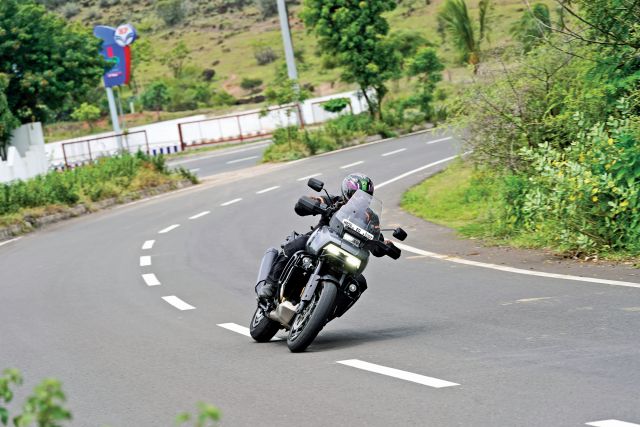
The Harley-Davidson Pan America will rumble along at 60 km/h in sixth gear at just below 2,000 rpm, but the motor doesn’t seem too happy spinning that low; third and fourth are ideal cogs for sedate city speeds. Things smoothen out upwards of 2,500 rpm and it feels like the bulk of that 128 Nm comes into play at around 3,500 rpm. From here, the Pan Am accelerates hard and will see the front wheel skimming over the tarmac through the first two gears when in Sport mode; thankfully the Öhlins steering damper does well to keep twitches at bay when that front wheel comes back down. 160 km/h comes up pretty effortlessly, although acceleration seems to flatten out by around 180 km/h. Claimed top speed is 220 km/h and that seems realistic; I saw 200 km/h before running out of road and revs were still rising in sixth gear. The six-speed gearbox works well and the ratios perfectly suit the engine’s character, although I would have preferred slightly smoother shifts, and the omission of a quickshifter on a bike this laden with tech is quite surprising.
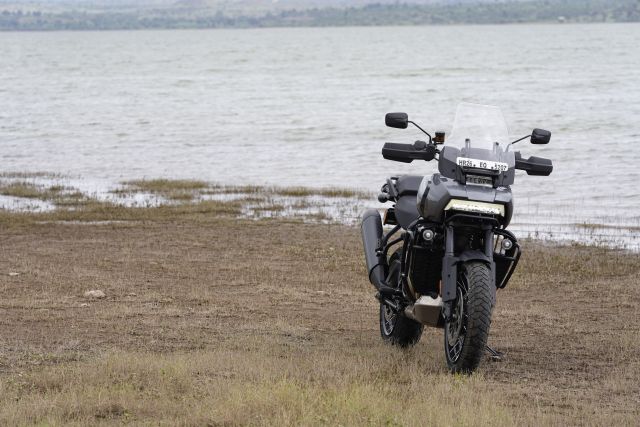
When you have a motorcycle weighing 254 kilograms travelling at these speeds, it is imperative to be able shed that speed in a hurry. A pair of 320-mm discs gripped by four-pot Brembo monobloc calipers up front are supplemented by a 280-mm disc with a single-pot caliper at the rear and a linked braking system ensures that some force goes to the rear wheel even when you just squeeze the front brake lever. This settles the chassis and keeps the bike stable when braking hard. The linked system is disconnected in Off-Road mode and can also be switched off from the Settings menu should you so desire. The brakes work well with excellent feel at the lever, although I would have liked a little more bite; then again, when I remind myself that there’s over a quarter of a ton bearing down on them, I must acknowledge that they do a good job when called upon.
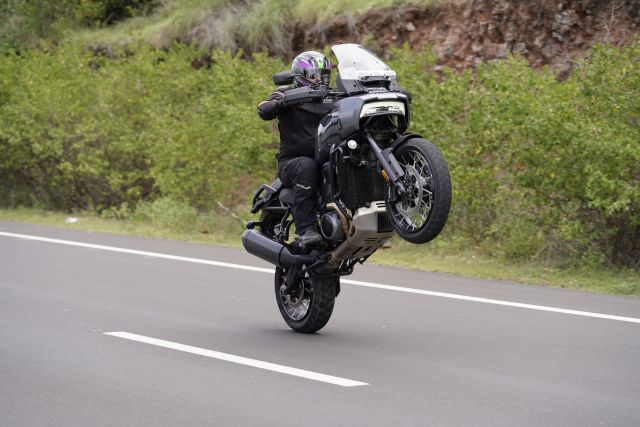
I was extremely impressed by the Showa semi-active suspension that our test bike sported at both ends, and the ease with which it allows you to tailor the ride quality on just about any surface. The Balanced setting seems to be a happy middle ground that works well in most conditions, while Comfort softens things up for a plush ride over bad roads. The ride gets quite firm in Sport, and aggressive riders will love this taut feel, which keeps dive when braking and rear squat when accelerating hard in check. The big, burly Pan Am can be coaxed to tip into corners without a hint of wallowing, and feels extremely stable at high lean angles, constantly communicating with the rider and boosting confidence; this is one Harley that loves twisties. There are also two more settings to the suspension: Off Road Soft for the more tentative off-roader who would rather roll gently over obstacles, and Off Road Firm, designed to absorb the big hits and jumps that are inevitable when riding hard off-piste. Additionally, preload at the linkage-mounted shock can also be adjusted electronically based on the load, or just leave it in Auto and the bike will take care of chassis attitude for you in varying load conditions.
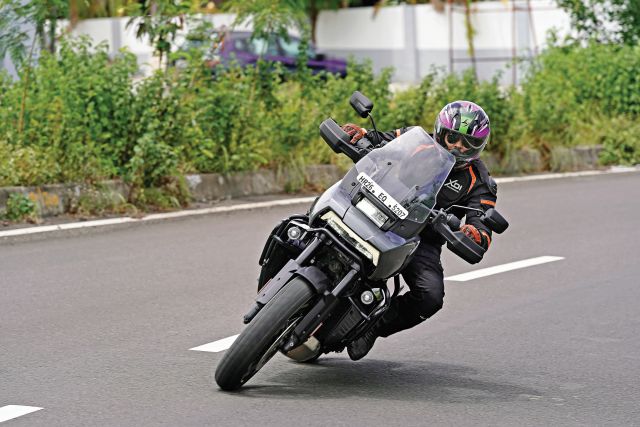
After a day and over 250 kilometres with the Harley-Davidson Pan America, I am convinced that Harley have knocked it out of the park on their first attempt, and built a capable, well-balanced machine to shake up the ADV market. The bike has its minor niggles; However, I enjoyed myself way more than I expected to, and it proved its mettle in a variety of conditions. Not only will the Pan Am attract Harley loyalists who wish to go further and faster than ever before, it should be a serious consideration for anybody in the market for a big ADV. Now I just can’t wait to see Harley slot this exciting engine into a proper American streetfighter; ready for a Rumble in the Bronx?
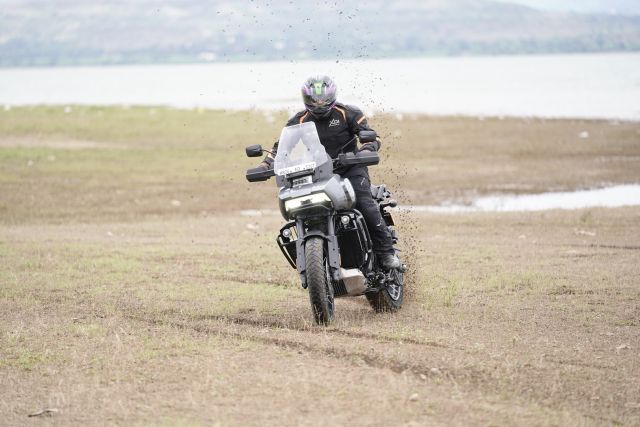


Leave a Reply